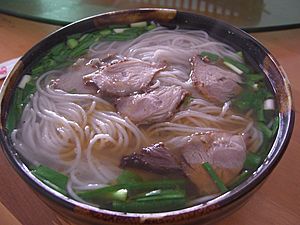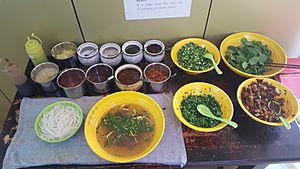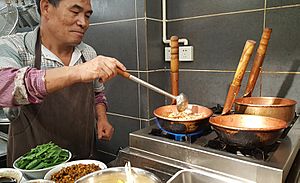Mixian (noodle) facts for kids

|
|
| Type | Chinese noodles |
|---|---|
| Place of origin | China |
| Region or state | Yunnan |
| Main ingredients | Non-glutinous rice |
| Variations | Ganjiang mixian, suanjiang mixian |
Mixian (simplified Chinese: 米线; traditional Chinese: 米線; pinyin: mǐxiàn) is a yummy type of rice noodle that comes from the Yunnan Province in China. These noodles are special because they are made from regular rice and are usually sold fresh, not dried. People in Yunnan love to eat Mixian!
Contents
Making Mixian Noodles
The way mixian is made in Yunnan is quite special. It involves a process called fermentation. This is when tiny living things, like yeast or bacteria, help change the food.
There are usually two main sizes of mixian noodles:
- A thinner noodle, about 1.5 millimeters wide.
- A thicker noodle, about 3.5 to 4 millimeters wide.
How to Enjoy Mixian
You can eat mixian in different ways. It's often served in a warm broth or stir-fried.
Stir-fried Mixian
Stir-fried mixian is a quick and popular dish, especially in the evening. You can often find it at roadside food stands all over Yunnan. It's usually cooked with ingredients like egg, tomato, meat, spring onion, and chili.
Mixian in Broth
One of the most famous mixian dishes is guoqiao mixian (過橋米線/过桥米线). Its name means 'crossing the bridge noodles'.
Most of the time, mixian served in broth is a very popular breakfast or daytime meal in Yunnan. The broth is usually made from chicken or beef, but other types exist too.
Adding Your Own Flavors
A fun part of eating mixian in broth is adding your own special ingredients! Restaurants often give you a variety of small dishes with different condiments. You can choose what you like to make your bowl perfect.
Usually, the noodles are put into the broth first. But sometimes, you get the noodles in one bowl and the broth in another. If this happens, you usually add your favorite toppings to the broth before adding the noodles.
Meat is also added to the broth. It can be bigger pieces, sometimes even with bone, or thin slices of meat.

Common Condiments
The condiments you can add can be very different, but here are some common ones:
- Chili pepper (fresh diced chili or chili pastes mixed with oil)
- Chrysanthemum flowers
- Coriander
- Mint
- Garlic (often finely chopped)
- Ginger
- Pepper (regular pepper or Sichuan pepper)
- Salt
- Sesame oil
- Sichuan pepper oil
- Soy sauce
- Spring onion
- Suan cai (a type of pickled vegetable)
- Tomato
- Vinegar
- Wood ear mushroom
- Zhe'ergen (a spicy root common in southwestern China)
Making your own rich and tasty broth is a big part of the mixian experience!
Where Mixian is Popular
Mixian is very popular in Yunnan Province, China. You can find it in many towns and villages there. It's harder to find outside of mainland China because it's usually sold fresh.
Some noodles in nearby countries like Laos (called feu) and Vietnam (called phở) are similar. However, with mixian, people in Yunnan love to add their own flavors to the broth. In Vietnam, the restaurant's broth is usually the main star.
See also
 In Spanish: Mi xian para niños
In Spanish: Mi xian para niños


